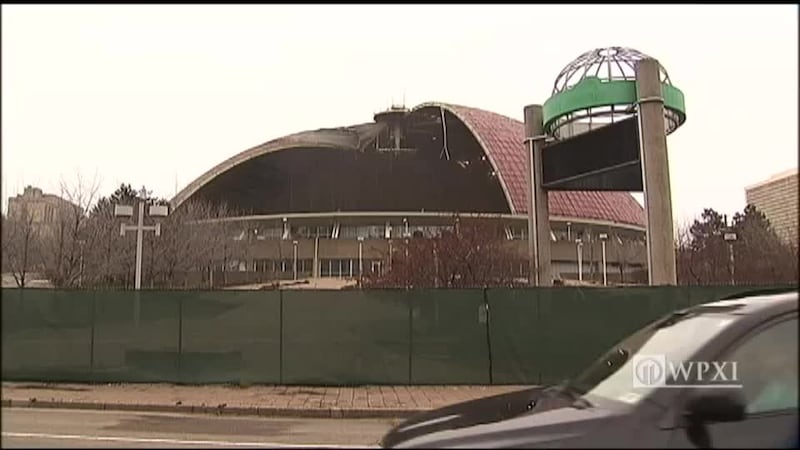PITTSBURGH — Known affectionately as “The Igloo” and officially called Mellon Arena at the time of its destruction, the Civic Arena was considered an ambitious architectural marvel at the time of its groundbreaking in 1958.
The $22 million project was pressured into existence by Kaufmann’s department store owner Edgar J. Kaufmann. He flexed his civic might as the president of the Civic Light Opera, as early as 1948 he made it clear to Mayor David L. Lawrence that his intention was to find a new home for the CLO, which had been performing at Pitt Stadium.
It is, perhaps, a surprise to modern Pittsburghers that the primary impetus to build the Civic Arena was not the Penguins hockey team. The team wasn’t in existence at the time of the groundbreaking, but would become an NHL expansion team in 1966. In fact, the team wouldn’t even adopt the Penguins name until 1967, inspired in part by the arena’s igloo shape.
The site of the new arena was a controversial and racially charged one. Large swaths of the culturally vibrant lower Hill District was seized by eminent domain. The largely African American community was separated from downtown as 8,000 residents and 400 businesses were forced to move. In the end, about 1/5th of the population of one of the city’s oldest neighborhoods was displaced and 80 city blocks, or about 100 acres, was flattened.
Even after the arena was completed, its vast parking lots were seen by many as an open wound where their neighborhood once stood.
With the CLO as the chief stakeholder and Kaufmann as the largest benefactor, the arena’s design was optimized for performances, not hockey.
William V. Winans, Jr. took extensive pictures of the Civic Arena during its construction. His complete collection is available on the Library & Archives at the Senator John Heinz History Center website.
The dome of the arena was clad in stainless steel, with a massive single supporting cantilevered arm. The opening roof was a signature design element and was, at the time, the world’s first major indoor sports stadium with a retractable roof. Six of the eight panels took 2 1/2 minutes to swing under the main arch, giving the seats inside a view of downtown that was unobstructed. Each panel weighed 220 tons.
The arena was officially known as the Civic Auditorium Amphitheater during construction, but sign makers decided that was too long for street signs. By the time the arena opened, it was commonly known by the shorter name: Civic Arena.
The arena officially opened on Sept. 17, 1961. Thousands gathered to watch the roof retract to reveal the skyline. The first event was the Ice Capades the following night.
Due to difficulties with the hydraulic jack system, the roof rarely opened after that. Full openings stopped in 1995 and the last full retraction was in 2001.
During its nearly 50 years of service to the city, it hosted the Stanley Cup Final three times, the NHL All-Star Game, NHL Entry Draft, both NCAA men’s and women’s basketball tournaments, competitions from wrestling to gymnastics and recording artists too numerous to list.
TRENDING NOW:
In 1999, Penguin’s star and team captain, Mario Lemieux, was the largest creditor after management encouraged players to defer their salaries for most of the decade. He proposed converting his deferred compensation to equity, the courts and NHL approved the deal and he saved the team from bankruptcy. Soon after the deal was complete, Lemieux began discussions to replace the Civic Arena.
As an interim fundraiser, naming rights to the Civic Arena were sold to Mellon Financial for $18 million and the name was changed to Mellon Arena. The naming rights expired after the building was already vacant.
The $321 million Consol Energy Center, later renamed PPG Paints Arena, opened on Aug. 28, 2010.
Once again known as the Civic Arena, the Igloo was the oldest and third smallest facility in the NHL at the time of its demolition.
The last event at the arena was a concert by James Taylor and Carole King. Their last song was also the swan song for the arena: “You Can Close Your Eyes.”
The arena’s unique design and eligibility for National Historic Landmark status briefly delayed it’s demolition. Various community and preservation groups’ efforts to preserve the arena failed to come to fruition and demolition began on Sept. 26, 2011.
The Civic Arena’s famed steel roof lives now as Christmas ornaments. The Penguins took the opportunity to save the stainless steel by contracting with Wendell August Forge to make the ornaments as a fundraiser for its charitable foundation, selling over 40,000 of them.
Since demolition finished in 2012, the arena’s location has been a parking lot. Redevelopment of the 28-acre site is currently in the planning stages.
© 2020 Cox Media Group
























































































